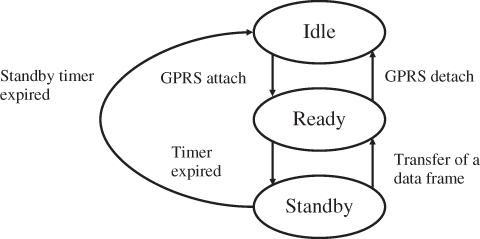2.4 The GPRS State Model
When the mobile device is attached to the GSM network, it can be either in ‘idle’ mode as long as there is no connection or in ‘dedicated’ mode during a voice call or exchange of signaling information. Figure 2.14 shows a new state model introduced to address the needs of a packet-switched connection for GPRS.
Figure 2.14 The GPRS state model.

The Idle State
In this state the mobile device is not attached to the GPRS network at all. This means that the serving GPRS support node (SGSN) is not aware of the user's location, no Packet Data Protocol (PDP) context is established and the network cannot forward any packets for the user. It is very unfortunate that the standards body named this state ‘idle’ because in the GSM circuit-switched ‘idle mode’ the mobile device is attached to the circuit-switched side of the network and is reachable by the network. Therefore, great care has to be taken not to mix up the packet-switched Idle state with the GSM circuit-switched idle mode.
The Ready State
When the user wants to attach to the GPRS network, the mobile device enters the ready state as soon the first packet is sent. While in ready state, the mobile device has to report every cell reselection to the network so that the SGSN can update the user's position in its database. This process is called ‘cell update’. It enables the network to send any incoming data for ...
Get From GSM to LTE: An Introduction to Mobile Networks and Mobile Broadband now with the O’Reilly learning platform.
O’Reilly members experience books, live events, courses curated by job role, and more from O’Reilly and nearly 200 top publishers.

